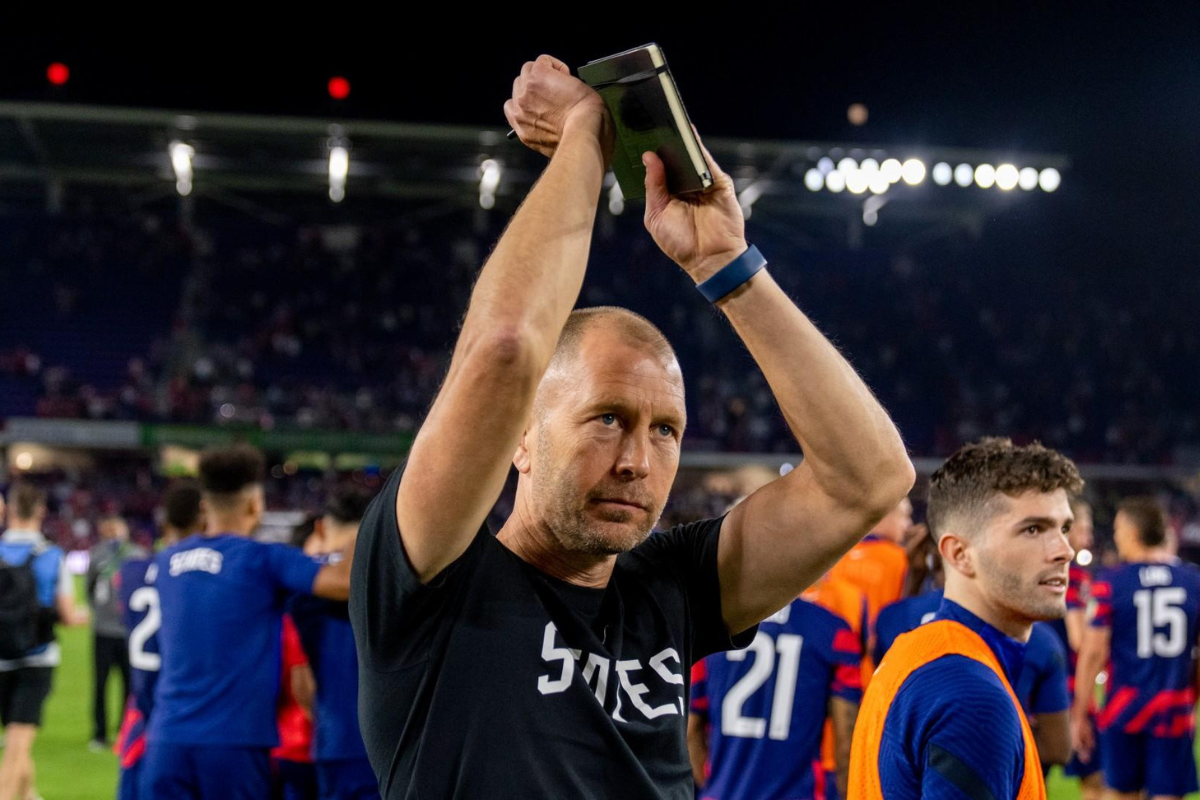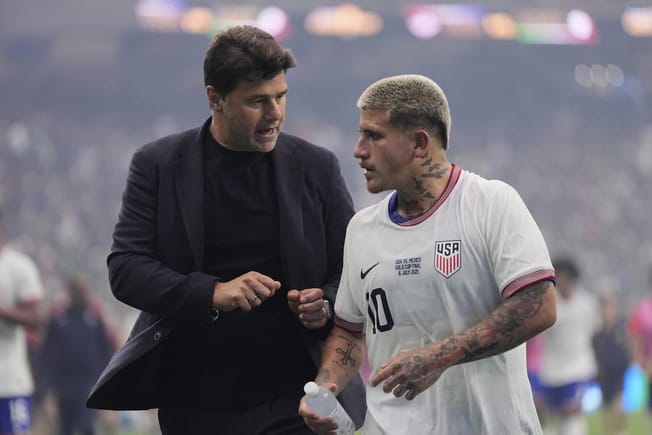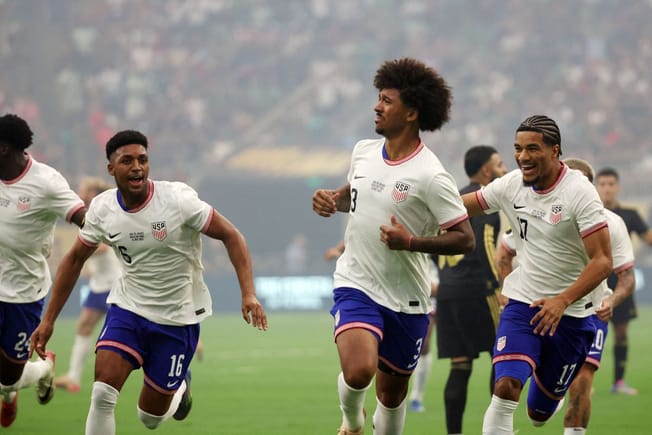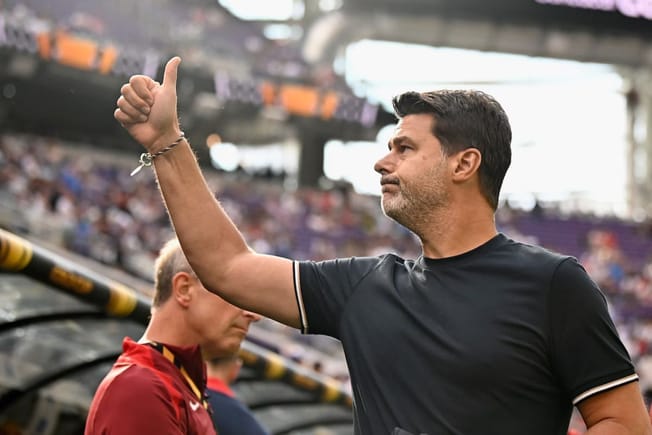Quick Hits
- Every manager has a defining game. Or a defining moment. Today, we’re examining some of the defining goals from Gregg Berhalter’s time in charge of the United States men’s national team
- From a 2019 friendly, to a 2021 final, to a 2022 World Cup qualifier, we can learn a lot about Berhalter’s tenure from these goals
Landon Donovan against Mexico in 2002, John Brooks against Ghana in 2014, Alvin Jones in Couva in 2017 — each of these goals helped define the tenures of previous United States men’s national team coaches. Before the USMNT takes the world’s biggest stage under Gregg Berhalter later this month, let’s pick out some defining moments for the current manager.
Here are the goals that define Berhalter’s time in charge of the United States.
ERICK GUTIERREZ 78’, USMNT 0-2 MEXICO (0-3 FINAL)
INTERNATIONAL FRIENDLY, SEPTEMBER 6, 2019
DOS A CEROOOOOU 👏👏👏👏👏
— TUDN USA (@TUDNUSA) September 7, 2019
DOS A CEROOOOOU 👏👏👏👏👏
El Guti hace el segundo para México y sentencia a la Selección de Estados Unidos 🔥🇲🇽🔥🇲🇽@USMNT 🇺🇸 0-2 🇲🇽 @miseleccionmx
Sigue el 🔴 En Vivo: https://t.co/3oef00Hhb9 #ChoqueDeGigantes | #GOL | #México pic.twitter.com/7yzc6hBwnR
Though he inherited a program in a state of relative turmoil after the U.S. failed to qualify for the 2018 World Cup, Berhalter preached lofty goals from his first day on the job. He said he wanted to “change the way the world views American soccer” and expressed his desire to make the U.S into a possession-based team.
“We want to use the ball to disorganize the opponent to create goal-scoring opportunities,” Berhalter said in January, 2019.
Ambitious? Yes. Logical? Maybe less so.
The player pool, although growing in talent, lacked individuals who were clean enough in possession for this technically demanding scheme. We could see that clearly in a 2019 friendly against Mexico, mere months after a loss to El Tri in the Gold Cup Final. Berhalter stuck to his possession-oriented guns and Erick Gutierrez’s goal for Mexico in the 78th minute was the result.
The USMNT looked helpless trying to play through Mexico’s press and Zack Steffen’s errant pass, which traveled directly into the path of a Mexican attacker, was the decisive blunder. Over eight months into Berhalter’s tenure, there was clearly a gap between locker room instruction and on-field execution.
Although Berhalter saw “progress” in the demolition, viewing the game as something of a training exercise, Gutierrez’s goal, and the 3-0 loss that followed, showed there was much to do to reach Berhalter’s idealistic philosophy.
CHRISTIAN PULISIC 114’, U.S. 3-2 MEXICO
CONCACAF NATIONS LEAGUE FINAL, JUNE 6, 2021
Almost two years after the USMNT’s humiliation in New Jersey, Berhalter faced Mexico yet again, this time in the Nations League Final. However, the state of the USMNT couldn’t have been more different for this game than it was in 2019.
For one, the team was far more youthful. Berhalter largely moved on from the old guard he inherited and instead built his team around a new generation of bright young talent. Berhalter’s approach also became more pragmatic. In camps in late 2020 and early 2021, he introduced a high press, which suited the player pool. Berhalter also took his foot slightly off the gas of his pure possession-based approach.
The final against Mexico was this new generation’s, and this modified system’s, first real test.
In what became an emotional and tightly-contested game, Christian Pulisic stepped up in extra time to score the game-winning goal for the United States. 3-2. Berhalter’s tactics didn’t steal the show, but what we saw in Denver against Mexico was the beginning of an identity. Berhalter’s team looked like they had a common goal — to fight tooth and nail for every ball and embrace the chaos.
There’s no better representation of that fledgling identity than a shirtless Pulisic shushing El Tri fans while beer rained down on him.
Pulisic’s celebrations vs Mexico across our three wins against them this year and the photos that have been taken of those celebrations deserve their own exhibit at the Museum of Fine Arts.#USMNT 🇺🇸 pic.twitter.com/1zKJiH7DLq
— USMNT 🇺🇸 Thoughts (@USMNT_Thoughts) November 13, 2021
RICARDO PEPI 75’, HONDURAS 1-2 U.S. (1-4 FINAL)
CONCACAF WORLD CUP QUALIFYING, SEPTEMBER 8, 2021
RICARDO PEPI WITH HIS DEBUT GOAL TO GIVE THE @USMNT THE LEAD 🇺🇸 pic.twitter.com/8UiNxA8mCO
— CBS Sports Golazo ⚽️ (@CBSSportsGolazo) September 9, 2021
After winning two trophies in the summer of 2021, the USMNT had plenty of optimism going into World Cup qualifying. Tyler Adams even expressed the goal to have a “nine-point week” as the team headed into their first set of three qualifiers. Instead, after two consecutive draws to open the campaign, Berhalter headed to the locker room down 1-0 at halftime in Honduras with his job presumably on the line.
All of a sudden, things seemed drastically different than they did just months prior. So what went wrong?
Players struggled to adapt to difficult away environments and Berhalter rotated his lineups and tinkered with his tactics between games, which didn’t allow his best players to be on the field together. Also, Berhalter was still trying to fit square pegs into round holes. Players like Adams and Weston McKennie weren’t strong enough in possession to help the U.S. create chances from methodical build-up play. The entire team struggled to consistently get the ball in dangerous spaces.
In the second half against Honduras, the USMNT finally picked up steam. Teenage striker Ricardo Pepi stepped up and possibly saved Berhalter’s job with his winning goal in the 75th minute. The goal wasn’t anything particularly special in itself, but thanks to Pepi’s salvo, the U.S. went on to win by a 4-1 scoreline and Berhalter and the team had a chance to regroup.
WESTON MCKENNIE 85’, U.S. 2-0 MEXICO
CONCACAF WORLD CUP QUALIFYING, NOVEMBER 12, 2021
DOS A CERO.
— U.S. Men's National Soccer Team (@USMNT) November 13, 2021
🇺🇸🇺🇸🇺🇸🇺🇸🇺🇸🇺🇸🇺🇸#USAvMEX x @allstate pic.twitter.com/I5NcVCXXg8
In press conferences prior to the USMNT’s October qualifiers, Berhalter stressed a desire for his team to be more direct in their movement and passing, to be more aggressive in the press, and to use their speed to get in behind opposing backlines.
Or, as Berhalter called it, “verticality”.
This change towards verticality led to Berhalter’s current magnum opus: a ‘Dos a Cero’ against Mexico in November. The USMNT played El Tri off the field in a way we’d never really seen before — at least not in recent history. They took control of the midfield and stretched Mexico’s backline constantly. McKennie’s goal, the second for the U.S. in the game, seemed almost inevitable. Mexico looked drained and hopeless in the second half and the USMNT still looked lively amongst the tired Mexican legs.
Dos A Cero’s revival diffused the criticism-laden cloud above Berhalter’s head that had formed from successive underwhelming windows.
SAM ADEKUGBE 90+5’, CANADA 2-0 U.S.
CONCACAF WORLD CUP QUALIFYING, JANUARY 30, 2022
SAM ADEKUGBE SCORES HIS FIRST GOAL FOR CANADA. 🔥🇨🇦 pic.twitter.com/AyCWcvrqox
— CBS Sports Golazo ⚽️ (@CBSSportsGolazo) January 30, 2022
When Berhalter’s team faced off against Canada in January, many fans hoped to see another version of November’s Mexico game. However, the legend of Dos a Cero giveth and taketh away and the U.S. lost 2-0 in Canada. The soccer gods have a taste for irony.
Going into the game, there were still issues that Berhalter had yet to address. For one, his teams seemed to always fall flat away from home. Also, the midfield and defense was not creative enough nor had the passing range to unlock a low block. Lastly, save Weah, none of the U.S.’s attackers could be depended on to create chances on a consistent basis.
All of these flaws reared their ugly heads against Canada, who, truthfully, didn’t even look their best. The USMNT seemed off-the-pace against John Herdman’s defensive approach and Sam Adekugbe’s stoppage time dagger snatched the last bit of hope that the United States could get at least a point on the road.
The U.S.’s inability to truly threaten in the attack proved costly. That, along with Berhalter’s unconcerned positivity in press conferences placed him on the hot seat with a World Cup spot still in the balance. Even Stephen A. Smith felt the need to comment on Berhalter’s job status.
Who says soccer isn’t mainstream?
BRENDEN AARONSON 26’, U.S. 1-0 MOROCCO (3-0 FINAL)
INTERNATIONAL FRIENDLY, JUNE 1, 2022
BA opens the scoring in Cincy!!! pic.twitter.com/IivRaTp7B6
— U.S. Men's National Soccer Team (@USMNT) June 2, 2022
Though the USMNT’s World Cup qualifying run was far from perfect, Berhalter got the job done and secured a spot in Qatar.
And as the summer came, so did a range of new tactical ideas. In June, it seemed Berhalter set out to fix some of the team’s flaws that were apparent during qualifying. He dropped Musah deeper to partner Adams, giving him additional support in possession and defensive help, and pushed another central midfielder higher up the field to give the U.S. more quality attacking personnel.
Berhalter first introduced these tactical tweaks against Morocco, and they looked like a stroke of genius after the first goal. Zimmerman pinged a ball up field to Pulisic, who made a smart run in behind. After a deft touch and a square pass to the on-rushing Aaronson, the U.S. were up 1-0 against a strong opponent. It looked easy.
The team looked far more effective in the attack and with more vertical movement, the USMNT didn’t have to rely on limited build-up play to create chances in possession. Now this was more like it.
DAICHI KAMADA 24’, JAPAN 1-0 U.S. (2-0 FINAL)
INTERNATIONAL FRIENDLY, SEPTEMBER 23, 2022
…and then this happened three months later.
After a summer window filled with attacking nuance and competitive desire, it looked like those things virtually disappeared in September against Japan. The USMNT attempted to build from the back despite looking error-prone in possession. There was no vertical movement and Zimmerman and Aaron Long couldn’t break lines with their passing. Although Matt Turner saved the U.S. from going down early, he could do nothing to stop Daichi Kamada’s strike after a U.S. giveaway in possession.
The USMNT looked lost and with several key players out, Berhalter’s team didn’t look like the product of an almost four-year project. Without much vertical threat and with an overreliance on building from the back, the U.S. played right into Japan’s hands and created almost nothing in the attack.
However, inconsistency on the road isn’t something new under Berhalter. They’ll need to find something away from home if they want to get out of the group stage at the World Cup.
Overall, Berhalter’s tenure has been a seesaw of emphatic successes and frustrating failures, and his defining goals reflect that.
Under Berhalter, the United States have gotten back to the World Cup – and we’ve witnessed some of the most impressive U.S. performances and goals in years. But by the same token, persistent flat performances and questionable coaching decisions have left us questioning whether Berhalter’s team is built for success.
Still, the most definitive goals come when the stakes are highest, and Berhalter still has his biggest test in front of him. The goals scored in Qatar will truly define his legacy – and Berhalter will certainly be hoping that those goals are scored by players wearing red, white, and blue and not any other set of colors.







Comments